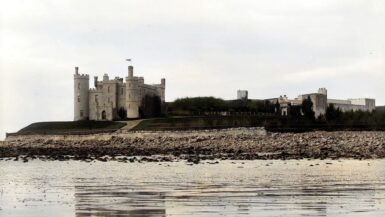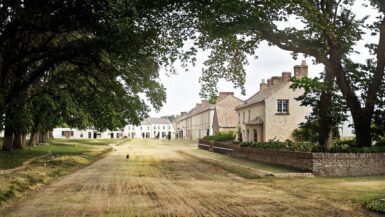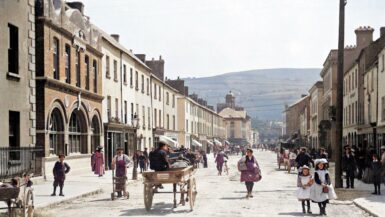Nestled in the heart of County Tipperary, Ireland, Carrigeen Castle is a remarkable testament to the rich history and architectural prowess of the region. With its picturesque setting and evocative past, the castle has become an essential destination for history buffs and travelers alike. In this comprehensive guide, we will delve into the captivating history of Carrigeen Castle, exploring its origins, transformation, and historical significance.
The Origins of Carrigeen Castle – A 15th Century Masterpiece
Built in the 15th century, Carrigeen Castle is a superb example of a medieval Irish tower house. The term “Carrigeen” is derived from the Irish word “Carraigín,” meaning “little rock,” a fitting name for the castle built on a rocky outcrop overlooking the lush Irish countryside. Originally constructed as a stronghold for the powerful Butler family, Carrigeen Castle played a crucial role in the turbulent politics and warfare of medieval Ireland.
The Powerful Butler Family – Lords of Carrigeen Castle
As prominent Anglo-Norman aristocrats, the Butler family held significant sway in Ireland, especially in the County Tipperary region. Carrigeen Castle served as one of their many strongholds, providing strategic control and a display of their wealth and power. The castle’s original design featured a square tower house, with four floors providing ample living space, storage, and defensive capabilities.
Throughout the centuries, the Butler family continued to maintain and expand Carrigeen Castle, adding various architectural features such as a fortified bawn wall and a gatehouse. This ongoing development is a testament to the castle’s enduring significance within the Butler family’s sphere of influence.
Carrigeen Castle – A Fortress in the Age of Conflict
During the 16th and 17th centuries, Ireland was embroiled in a series of conflicts, both internal and with the English Crown. As a stronghold for the powerful Butler family, Carrigeen Castle found itself at the center of these tumultuous events.
In 1598, during the Nine Years’ War, the castle was besieged by Irish forces led by Hugh O’Neill, Earl of Tyrone. Despite the ferocity of the attack, Carrigeen Castle held strong, showcasing the castle’s impressive defensive capabilities.
The castle’s resilience was tested once again during the Cromwellian Conquest of Ireland (1649-1653), led by Oliver Cromwell. This period saw Carrigeen Castle change hands multiple times, as it was captured and recaptured by various factions. Ultimately, the castle survived these turbulent times and remained a prominent symbol of the Butler family’s influence.
Carrigeen Castle’s Restoration – A Return to Former Glory
Following the turbulence of the 17th century, Carrigeen Castle fell into disrepair. However, in the 19th century, the castle experienced a new lease on life, as descendants of the original Butler family began the process of restoration.
This extensive restoration saw the castle transformed from a crumbling ruin to a stunning, habitable residence. The 19th-century renovations included the installation of elegant Gothic-style windows, a new roof, and various other architectural improvements. This period of restoration saw Carrigeen Castle evolve into the enchanting structure that can be admired today.
Carrigeen Castle Today – A Living Piece of Irish History
In the 20th century, Carrigeen Castle was purchased by the Everard family, who continued the restoration efforts initiated by the Butler family. Under their stewardship, the castle became a treasured landmark, and a window into the past of County Tipperary and Ireland as a whole.
Today, Carrigeen Castle has been lovingly restored to its former glory, with careful attention paid to preserving its historical charm and authenticity. As a result, visitors can experience a genuine taste of medieval Irish life, from the imposing stone walls to the intricately carved wooden features.
Carrigeen Castle – A Premier Tourist Destination in County Tipperary
Carrigeen Castle now operates as a popular tourist attraction, offering guided tours that delve into the rich history of the castle and the Butler family. Visitors can explore the various rooms within the tower house, marvel at the impressive bawn wall and gatehouse, and take in the stunning views of the surrounding countryside from the castle’s battlements.
In addition to guided tours, Carrigeen Castle has also found new life as a charming bed and breakfast. This unique accommodation experience allows guests to stay within the historic walls of the castle, providing an unforgettable experience that truly brings history to life.
Carrigeen Castle’s Historical Significance – A Testament to Ireland’s Past
The history of Carrigeen Castle is a microcosm of Ireland’s broader history, reflecting the many changes, conflicts, and transformations the country has experienced over the centuries. As a stronghold of the powerful Butler family, the castle bears witness to the shifting political landscape of medieval Ireland, as well as the architectural innovations of the time.
Carrigeen Castle’s endurance through periods of strife, such as the Nine Years’ War and the Cromwellian Conquest, is a testament to the resilience of Irish culture and the unyielding spirit of the people. The castle’s restoration in the 19th and 20th centuries showcases the ongoing commitment to preserving Ireland’s rich heritage and ensuring that future generations can appreciate the country’s storied past.
Visiting Carrigeen Castle – A Journey Through Time
For those seeking an unforgettable journey through Ireland’s history, Carrigeen Castle is an essential destination. Located just a short drive from the town of Cahir in County Tipperary, the castle offers easy access to other historical sites and natural attractions in the region, including the Rock of Cashel, Cahir Castle, and the stunning Glen of Aherlow.
Whether you choose to explore the castle on a guided tour or stay overnight in the unique bed and breakfast, Carrigeen Castle promises to captivate and inspire with its enchanting blend of history, architecture, and natural beauty.





Leave a reply